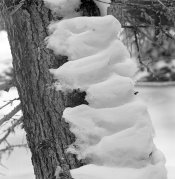I will have to try it if we get any snow this winter!
The Sunny 16 less one stop, i.e. becoming Sunny 22 on snow is still relevant though and in bright to average light, is probably accurate enough (especially for black and white).
Steve.
A single observation from last Monday, a sunny day with full snow cover within 24 hours of the snow falling, no melting yet, sun 18.5 degrees off the horizon in the late morning, incident metered for a subject fully front lit by the sun (photographer's back to the sun). Note that the sun doesn't get higher than 26 degrees off the horizon here this time of year, so I couldn't meter with the sun much higher than it was.
ISO 125 incident meter reading gave EV 15.67. That's f:16 +2/3 at 1/125th, or 2/3 of a stop less exposure than "sunny 16". The meter I used reads in 1/3 stop increments, so it could have been anywhere between 1/2 to 5/6 of a stop less exposure than "sunny 16".
BTW, the reflected reading off the front lit snow on the ground in front of me gave EV 17. I only aimed below horizontal far enough to fill the meter coverage with snow on the flat ground in front of me (avoiding my shadow), so the difference between incident and reflective reading of front lit snow only was 1.33 stops.
I also did this same check aiming toward the sun and wrote the readings on a small receipt in the car as I left for errands. I put it where it would be safe, and it's still safe, wherever it is... So don't hold me to the following data. There was obviously a somewhat more specular character to the reflected snow reading with the sun only 18.5 degrees above it, and IIRC the difference between incident and reflective readings was 4 1/3 stops. You also need to take into account that the standard "correct" way of reading this scene in incident mode would be to have the dome of the meter pointed away from the sun in nearly full shade with the sun at that altitude. You'd likely get better results by holding the meter dome pointed straight up or tilted 45 degrees from straight up (angled away from the sun) in this case.
Lee





